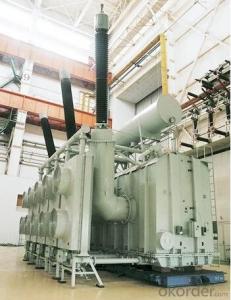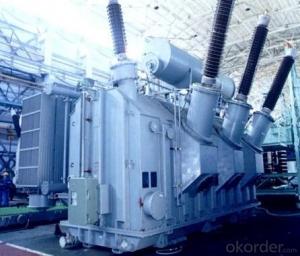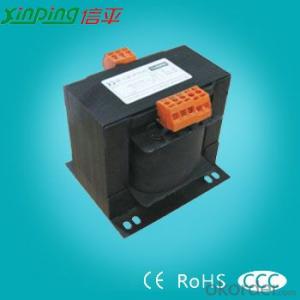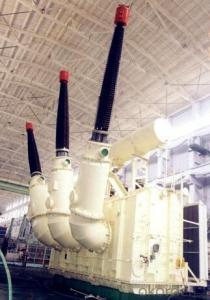360MVA/63kV main transformer for Hydro power station
- Loading Port:
- Tianjin
- Payment Terms:
- TT OR LC
- Min Order Qty:
- 1 pc
- Supply Capability:
- 1 pc/month
OKorder Service Pledge
OKorder Financial Service
You Might Also Like
Quick Details
| Place of Origin: | HeBei | Brand Name: | CNBM | Model Number: |
|
| Usage: | Power | Phase: | Coil Structure: | Toroidal | |
| Coil Number: | Capacity: | Rated Voltage: | 360MVA/63kV | ||
| Connection Symbol: | YNd11 Dyn11 YNyn0d11 | Tank: | Cover type or Bell type | OLTC: | MR or ABB or SMS |
Packaging & Delivery
| Packaging Detail: | Mainbody --naked Disassembled parts -- crate |
| Delivery Detail: | 3 months |
Specifications
1. CESI certificate
2. High short-circuit withstand
3. Low loss, PD and noise
4. CTQC certificate
5. No leakage
Description
The application of the 360MVA/63kV main transformer for Hydro power station.can significantly improve the economy of the OLTC substation, and matches well with the transmission capacity of OLTC lines, which has wide prospect of application. Because of its large capacity and large volume, the whole transportation weight with nitrogen is about 470-490 tons, and due to the restricted transport conditions, the transportation becomes the critical issue for the 360MVA/63kV main transformer for Hydro power station. In order to make the products applicable to any OLTC substation in our country, the state grid of corporation of China set the "A study of easy-transport large capacity OLTC Transformer” as a key scientific research projects, and entrusted BTW to carry out the research.
During the process of research and development, BTW adopted the advanced design technology and modular design, the transformer can be transported disassembly and with advantages of compact core and winding body, less transportation weight and low transportation cost, effectively solves the need of OLTC construction in the transportation restricted areas. By using the most advanced 3D magnetic field calculation software, BTW performed detailed analysis and calculation for the magnetic flux leakage and eddy current loss of the transformer coil, iron core and oil tank steel structures. Besides, by using of the advanced electric field calculation software, BTW performed detailed analysis and calculation of main longitudinal insulation, and mastered the arrangement of the main longitudinal insulation of large capacity OLTCtransformer and the control of distribution of winding magnetic flux leakage. All of which make the products with low loss, low noise, small volume, strong anti short circuit ability, no local overheating and other significant advantages, and guarantee the long-term safe and stable operation.
The world's first on-site assembled large capacity OLTC Transformer’s right at the first time once again filled the gap in the field of OLTC transformer research after Chinese transformer industry overcame the difficulty of integral transport of the 360MVA/63kV main transformer for Hydro power station, which marks BTW has fully occupied the world transformer industry technical peak. The successful development of the product filled the gaps in the domestic technology and met the urgent need of OLTCconstruction application in our country, greatly improved the technical level and manufacturing ability of BTW in terms of OLTC Transformer products.
- Q: I have a US microscope (110v) with a built-in transformer using a 6v, 10w lamp. I want to use this with a 220 v supply. What are the specifications for the cheapest (external) transformer I can use for this purpose?
- cheapest would be a simple voltage regulator you build yourself. a 2:1 transformer.
- Q: What is the maximum current of the 800KVA transformer? What is the current? Is how to calculate, ask you master
- This type of capacity of the transformer for the distribution transformer, that is, step-down transformer. Voltage combination to 10 / 0.4 for multi-purpose. Transformer high side current 46.19A, low side current 1154.73A. Rated capacity = 1.732 * rated voltage * rated current
- Q: Transformer capacity unit KVA? Transformer capacity unit KVA is how is it? 10KVA transformer, the maximum number of KW can be connected to electrical appliances? Supplementary - 2006-07-27 10:00:32 30KVA transformer, the maximum number of KW can be connected to electrical appliances? We plan to rent a workshop, there are power 380V, transformer capacity 30KVA. I want to install an electric furnace 75KW, welding machine 53KW, there are other small power appliances. Transformer capacity enough? I am full of transformer on the layman, please explain in detail, do not rhetoric.
- What is the difference between kv, kva and mva? The kilovolt ampere (kVA) is the power measurement standard that is 1 kilovolt ampere. KVA is equivalent to the current in a circuit generated by the voltage of that line, usually measured in the transformer, that is he is a current unit. And kilowatts refers to the power of an electrical, that is, the power of the unit. The rated capacity represents the guaranteed value of the transformer output power under rated operating conditions and is the apparent power of the transformer. That is, the maximum output power of the transformer capacity, the transformer can not be the actual output power and capacity to be confused. The units are voltammetry (VA), kVA, and MVA.
- Q: Transformer Transformer Principle
- Summary of words: Electrosagnetism. Magnetic electricity. Its basic principle is: a coil and the secondary coil around the same core, when a coil power, the alternating magnetic flux in the core, (magnetism) the alternating magnetic flux through the secondary Coil, according to the law of electromagnetic induction, will produce alternating electric potential in the secondary coil, (magnetic power) due to a secondary side of the coil turns, therefore, the secondary side of the voltage will not wait.
- Q: HiCan anybody help with the below question?A 400V, 3 phase supply is connected through a 3 phase loss-free transformer of ratio 1:1, which has its primary connected in mesh and secondary in star, to a load comprising three 20 ohm resistors connected in deltaCalculate the currents in the transformer windings, in the resistors and in the lines to the supply and the load. Find also the total power supplied and the power dissipated by each resistor.Thanks in advance
- The transformer is connected delta-wye (mesh-star), so the secondary voltage is: Vs400V x sqrt(3) 692.82V (line-to-line) Current in each resistor is: IrE/R692.82V/20ohm34.64A Line current on secondary is: Ils34.64A x sqrt(3) 60.00A Current in each secondary winding: Isw Ils 60.00A Current in each primary winding: Ipw Isw 60.00A (because windings are 1:1) Primary line current: Ilp Ipw x sqrt(3) 60.00A x sqrt(3) 103.92A Check: Primary and secondary kVA should be the same: kVAp400Vx103.92Axsqrt(3)/100072.0kVA kVAs692.82Vx60.00Axsqrt(3)/100072.0k It checks Since load is purely resistive, kVAkW. Total power: 72.0kW Power per resistor: 72.0kW/3 24kW
- Q: A 120-V, 60-H air conductor is to be operated in a remote area where the voltage drop in the long transmission line results in a utilization voltage of 102-V. Determine:A) the required step-up voltage ratio for the satisfactory performance.B) The voltage ratio of a standard buck-boost transformer that most closely meets the requirements of the loadC) The voltage at the load with the buck-boost transformer installedD) Sketch the appropriate connection diagram and show the NEWM standard terminal markings
- I already answered this. First, what is satisfactory performance? Is the 102 volts the lowest the voltage reaches? I asked you this last time, and I still don't see an answer. If 102 is the lowest, than adding 10 volts is all you need, as that gets you 112 volts, and any 120 volt appliance will operate fine at 110 volts. A 120 to 12 volt transformer is easy to find, and with 102 volts input you will get 10 volts output, and added to 102 that gives you 112 volts, plenty to operate the AC. Parts of this question read like a homework problem, but parts don't such as the undefined term satisfactory performance, so which is it?
- Q: Guys can you tell me that how can I calculate transformer winding?Example:- I need (12volts, 4Amps, 50Hz on Secondary's side of transformer and give 230volts 50Hz on Primary's side of transformer) how I calculate the wire's number of turns? In this case I can give different values of current like 1Amp, 2Amps, 3Amps etc on Primary's side of transformer. But I need constant 12volts, 4Amps, 50Hz on secondary. So how can I calculate.Please give an answer with an example basis on (0-12) transformer.
- Basically, the ratio of voltages is the same as the ratio of turns. The currents are the inverse ratio but that kind of takes care of itself if you just deal with the voltage ratio.
- Q: e in the past with followings already??? I'm just curious I mean Transformers is at 700 mill where everything else is in the 300 mill range which isn't a bad thing but I'm just wonderin'thanksand please give like 5 or more sentences, not a because it rocks
- the guys go crazy for megan fox.
- Q: Hey I was just wondering if the Nintendo DS version of the Transformers:Revenge of The Fallen game still had the Create-A-bot feature where you can customize your own transformer or if you had to play as the movie characters?
- it actually relies upon on what style of video games you like. See, Transformers: Revenge of the Fallen has so lots extra action than Pokemon Platinum (my brother has it). you ought to use your wits to conflict enemies and gain missions. yet Pokemon Platinum has an thrilling plot besides and in evaluation to in the 1st Transformers recreation, you do not die. you apart from would get to make judgements in Pokemon besides, so it has a extra versatile tale consistent with the place you desire to take it. So in the experience that your extra into violence and explosions, Transformers: Revenge of the Fallen, is the recreation for you. in case you desire to play around in destiny and be the main appropriate at issues, Pokemon Platinum is yours. P.S-i'm for the two.
- Q: Transformer insulation level L175 AC35 / 5 What does it mean
- 2, the insulation level of the transformer is according to the high pressure, medium voltage, low voltage winding sequence listed in the tolerance voltage value (the impact level in the former), during which separated by a slash. The neutral insulation level of the graded insulation is followed by a horizontal line at its wire end insulation level. Such as: LI850AC360-LI400AC200 / LI480AC200-LI250AC95 / LI75AC35. Meaning: 220KV three-side insulation of the main transformer, high-voltage side of the lead-side lightning impulse withstand voltage is 850kV, power frequency withstand voltage is 360kV, high-voltage side of the neutral point of the terminal lightning impulse withstand voltage is 400kV, power frequency resistance The voltage is 200kV;
Send your message to us
360MVA/63kV main transformer for Hydro power station
- Loading Port:
- Tianjin
- Payment Terms:
- TT OR LC
- Min Order Qty:
- 1 pc
- Supply Capability:
- 1 pc/month
OKorder Service Pledge
OKorder Financial Service
Similar products
Hot products
Hot Searches
Related keywords






















